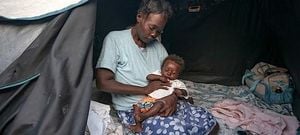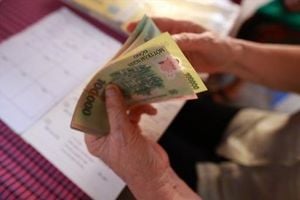On October 11, 2025, former first lady Michelle Obama’s Girls Opportunity Alliance announced a bold new pledge: $2.5 million in funding dedicated to grassroots groups working tirelessly to advance education for adolescent girls in some of the world’s most economically disadvantaged regions. The announcement, made on the International Day of the Girl, couldn’t have come at a more critical moment. With global education funding facing steep cuts and millions of girls at risk of being forced out of school, the Alliance’s renewed commitment is both a lifeline and a rallying cry for advocates worldwide.
According to UNICEF, nearly three-quarters of the 119 million girls currently out of school are of secondary school age—a staggering figure that underscores the magnitude of the challenge. The barriers these girls face are daunting: prohibitive school-related costs, entrenched patriarchal practices like child marriage, and the trauma of sexual abuse, to name just a few. The Girls Opportunity Alliance, an initiative of the Obama Foundation, is stepping up to meet these challenges head-on by putting resources directly into the hands of those who know their communities best.
“These groups are changing the way girls see themselves in their own communities and in our world, helping create the leaders we need for the brighter future we all deserve,” Michelle Obama said in a video shared with the public on October 11. “Because when our girls succeed, we all do.” Her words reflect a fundamental belief in the power of grassroots action and local leadership—a philosophy that has guided the Alliance since its inception in 2018.
The Alliance itself is the outgrowth of a White House initiative that invested $1 billion in U.S. government programs promoting adolescent girls’ education abroad. Building on that foundation, the Girls Opportunity Alliance zeroes in on supporting girls between the ages of 10 and 19, aiming to help them not only stay in school but also thrive and lead. The latest $2.5 million pledge is intended to fund specific, targeted projects rather than general operations, with grants of up to $50,000 available to each recipient organization.
“The need right now, I think more than ever, is crucial,” said Tiffany Drake, Executive Director of the Girls Opportunity Alliance, in remarks reported by the Associated Press. That sense of urgency was palpable at the Alliance’s early October convening in Mauritius, where Asian and African members of the network gathered to share stories, strategies, and hard-won lessons. Drake recalled, “We were just in Mauritius and we heard it time and time again that organizations need funding. They need support.”
The Mauritius gathering, described by Drake as perhaps the most moving the Alliance has hosted, brought together leaders from communities facing enormous obstacles with few resources. Yet, amid the challenges, there was also hope and solidarity. Jackie Bomboma, founder of the Young Strong Mothers Foundation in Tanzania and a recent grant recipient, said that connecting with other powerful women left her encouraged and less alone in her mission. Her organization provides psychological support, vocational training, entrepreneurship skills, and sexual health lessons to hundreds of girls at risk of child marriage, teenage pregnancy, and dropping out of school.
Bomboma’s own life story—growing up without a mother and surviving teenage pregnancy—deeply informs her work. The Alliance’s support, she said, goes far beyond financial aid. “We call ourselves ‘watoto wa Michelle Obama,’ which means ‘the children of Michelle Obama,’” Bomboma told the Associated Press. “So, everyone feels so proud to have such a mother who is very strong, who is very powerful and who is very loving.” The Obama Foundation’s endorsement, she added, brings not only funding but also increased trust from the international community and new pathways to resources.
But the Alliance’s support doesn’t stop at grants. Once organizations join the network, their leaders gain access to monthly training sessions—both online and in person—where they can connect with larger NGOs such as UNICEF and Save the Children. These gatherings are more than just meetings; they’re opportunities to share strategies, build networks, and learn from one another. The Alliance also promotes fundraising campaigns for its grantees, leveraging its broad platform, social media presence, and connections with celebrities and corporations to help organizations raise additional funds through GoFundMe and other channels.
“We didn’t want to just tell people and say, ‘Google how you can help,’” Drake explained to the Associated Press. “We wanted to give them a place where they can take action.” The idea is simple but powerful: use the Alliance’s “megaphone” to shine a spotlight on organizations that often struggle for visibility and support, especially those in remote or underserved areas. The hope is that everyday individuals, inspired by these stories, will be moved to join the cause.
The stakes, however, have never been higher. International aid groups and UNICEF are sounding the alarm about looming budget cuts. A projected 24% drop in global education funding from wealthy countries could force an additional six million girls out of school by the end of 2026. This threat looms over communities already stretched to their limits, threatening to undo years of hard-fought progress. The Alliance’s new funding commitment is a direct response to this crisis, aiming to shore up the efforts of local leaders just as they face mounting pressures.
The Girls Opportunity Alliance’s approach is intentionally flexible and responsive. Anyone can apply for a grant of up to $50,000, so long as the funding goes to a specific project rather than general operations. Once accepted, recipients are welcomed into a network that offers not just money but also knowledge, mentorship, and a sense of global community. The Alliance’s campaigns are promoted publicly, giving organizations a shot at the kind of attention and support that can make all the difference.
In the end, the story of the Girls Opportunity Alliance is as much about hope as it is about hardship. It’s about girls who, against the odds, are rewriting their futures—and about a global movement determined to stand with them. As Bomboma put it, having the support of Michelle Obama and the Alliance gives her and the girls she serves the confidence to keep pushing forward. The message is clear: when girls are given the chance to succeed, the benefits ripple outward, touching families, communities, and the world at large.
With funding, solidarity, and a powerful “megaphone,” the Alliance is helping grassroots organizations turn the tide in the fight for girls’ education, one project—and one girl—at a time.




